04 September 2024
|
Azul is a modern classic of the board gaming world, but it's grown beyond its original game, offering us choices when we come to play or buy. We're taking you through the options, and why you might buy each one specifically.
Written by Charlie Pettit
What is the board game Azul?
The board game world has many beautiful games, but Azul is a real crowd-pleaser. It’s not beautiful in the way a watercolour painting is, but instead in its vibrancy and tactility. The game began with the goal of creating a stunning mosaic, using small plastic tiles that you’ll bring together to make a satisfying and eye-catching creation – to then score the most points for. Azul has been a fantastic gateway game for many gamers, and it’s never difficult to convince someone to bring it to the table.

The game was made by Michael Kiesling, who is a long standing game designer with a wide range of successful board games to his name.
Which Azul is Best?
Azul was fantastically popular, winning a Spiel Des Jahres in 2018 – one of the biggest accolades in board games – and so it’s no surprise that the game didn’t stop with Azul. Since its release, there have been three additional Azul games, as well as some variant games as well – new themes, or smaller versions for example. We’ve reviewed them over the years within Tabletop Gaming magazine, and so we can offer a few recommendations…
Azul
The original Azul takes you back to the time of Portuguese king Manuel I, who visited an Alhambra Palace in Spain and decided he needed his palace to be decorated similarly. Those tiles – azulejos – lend their name to Azul, though using multicoloured tiles to create the best mosaic the Royal Palace of Evora has ever seen.

In this game, you select the same coloured tiles from circular tiles. Those that aren’t the same colour, fall to the floor (the centre of the tile selection area), and the same coloured tiles from there can be picked up by another player. You’ll then place the tiles selected onto your game board, but you need to complete a row – more tiles are needed to complete the bottom row (5) than the first (1). At the end of the round, when all tiles are used, the completed rows reward you with one tile to place on that piece on your board.
The fun of this is that you’re not only trying to get the right colours, but you’re also trying to stop your opponent from doing the same, or ensuring you don’t end up with a big stack of one colour that you can’t use on your board at the end. You get points for tiles, but also their placement, so creating something visually pleasing is also rewarded with points. It’s a puzzle type game that has remained popular for a reason.
You should buy Azul if you’re new to the series. The original is arguably the best for a light crowd, it does exactly what it sets out to do, and it does it in an exceedingly satisfying way.
Azul: Stained Glass of Sintra
Where do you go from Azul? Well, you add in some new shapes and complexities, but maintain the fun of creating something visually appealing – only this time, it’s stained glass windows.
Players will select glass panes to fill in their windows, which are made up of translucent window pane pieces that look a little like sweets, in the same square shape as the original Azul game. There’s a thread of similarities between the original and this version, but there are additional rules to consider – a glazier pawn marks areas you can score, and it’s trickier to discard unwanted pieces, which make it feel more complex than the original Azul.
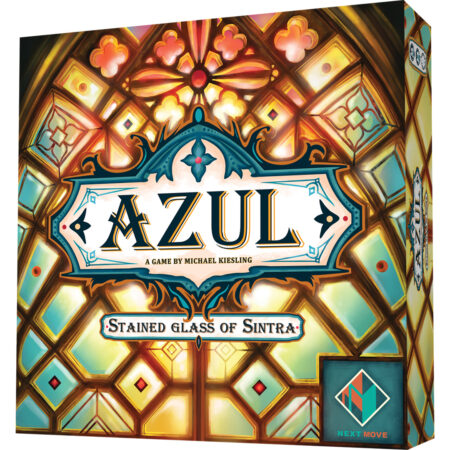
In our full review of Stained Glass of Sintra, we said you should probably play this game, but that you wouldn’t benefit from owning both it and Azul. If you own neither though, pick up Stained Glass of Sintra if you prefer a little more strategy in your game.
Buy Azul: Stained Glass of Sintra on Amazon
Azul: Summer Pavilion
Taking the square tiles of Azul and swapping them for diamonds placed in a pattern that makes beautiful flowers, Azul: Summer Pavilion takes the heart of Azul's beautiful tile laying and places it into a whole new light.
Though the thread of Azul is still there, this game feels more distinct from its predecessor. You’re creating beautiful star patterns from diamond-shaped pieces, following mostly the same rules as with Azul – collecting enough pieces to be able to place a single piece on the board. Now though, you have much more choice on where you can place them, you have the benefit of wild card tokens, and additional point and token-taking opportunities based on your placements.
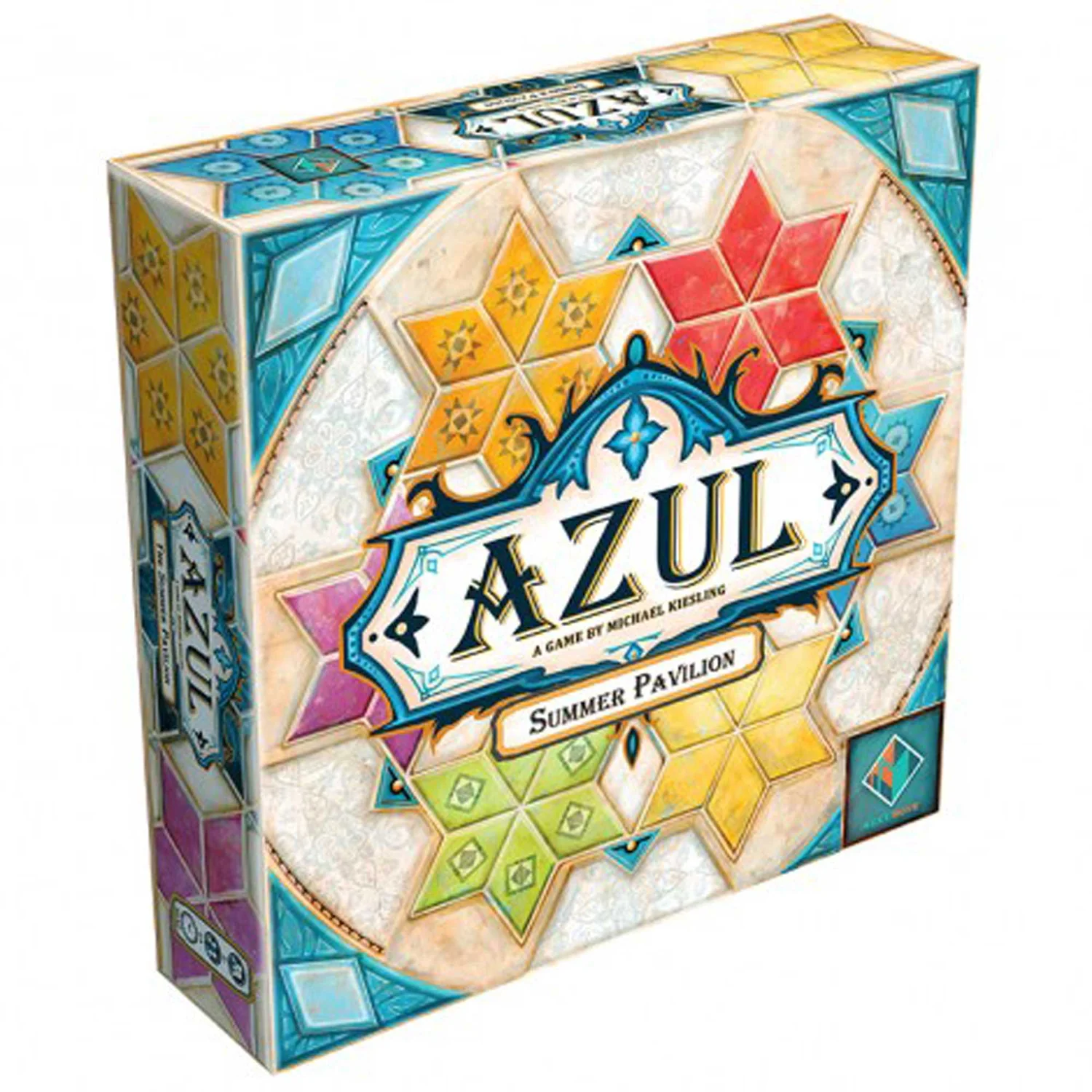
And whilst it’s got a few extra mechanics than the base game of Azul, arguably this one feels much more like a designer has grown a new game from its original roots. Azul is a fantastic game, but Summer Pavillion feels like its wiser sibling.
You should pick up Azul: Summer Pavillion if you enjoyed Azul but have played it enough, as it offers the same tick boxes of enjoyment that Azul does, but with a little more oomph, or if you’ve not played either game, but have played a few modern board games already.
Buy Azul: Summer Pavilion on Amazon
Azul: Queen's Garden
Lastly, Azul: Queen’s Garden sees you arranging a beautiful garden for Queen Maria of Aragon. Azul and Stained Glass of Sintra gave us square tiles, the Summer Pavilion gave us diamond shaped tiles, and Queen’s Garden added a new shape, with hexagonal tiles to add to the challenge – but aside from the shapes, it’s the furthest departure from the original.

In this version, there are both patterns and colours to contend with, and you’ll select one of either (rather than just a colour). There are stacks of tiles to use, with the drafting having changed considerably from those Azul games before it. There are also a lot more mechanical rules about your placement and how these are scored.
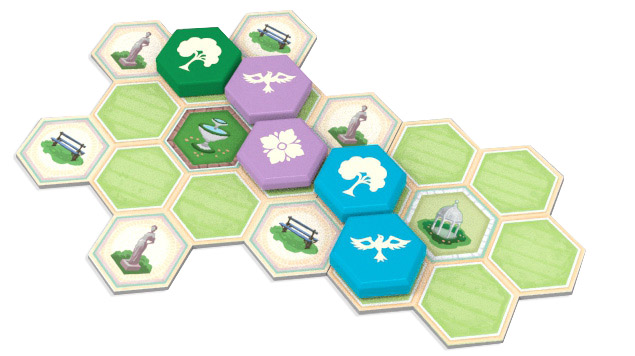
Queen’s Garden feels much less like Azul, so this is a great pick for someone who enjoys a tile laying game but wasn’t enamoured with, or fell out of love with the original Azul. It’s also a good game for the hobbyist gamer, for whom the additional rules and strategy aren’t a problem, as this version is a little less of a gateway game than the predecessors.
Buy Azul: Queen's Garden on Amazon
Azul Expansions and Variations
Perhaps you’ve already picked your favourite Azul, or maybe you own them all already, and are looking for even more options. Well, that’s where the expansions and variations come in…
Azul: Master Chocolatier

This is a reskin and slight update of the original Azul. Now, instead of building a mosaic, you’re joining the best chocolate makers of the world, with tiles themed to look like luxury chocolate pieces instead. The game adds a special effect to modify play when you’re playing on the flipside of the factory tile, which adds a little extra something, but is otherwise the same game.
This was a limited edition, so is harder to find than the alternatives. You should pick this one up if you’re not bothered by the theming, or want to collect it, but arguably the tiles are more beautiful in the original game…
Buy Azul: Master Chocolatier on Amazon
Azul: Crystal Mosaic

An expansion for Azul came in Crystal Mosaic, which simply gave additional player boards that let you place differently to enjoy new strategies. The winner for this though was really the plastic overlays that sit on top of the player boards, which have recesses that prevent your tiles from moving, and also keeps them uniform. Those plastic tiles can be a little slippery, and although its satisfying, you do spend a good chunk of time lining them up perfectly.
Azul: Crystal Mosaic is one to pick up if you’re a frequent Azul player.
Buy Azul: Crystal Mosaic on Amazon
Azul: Glazed Pavilion
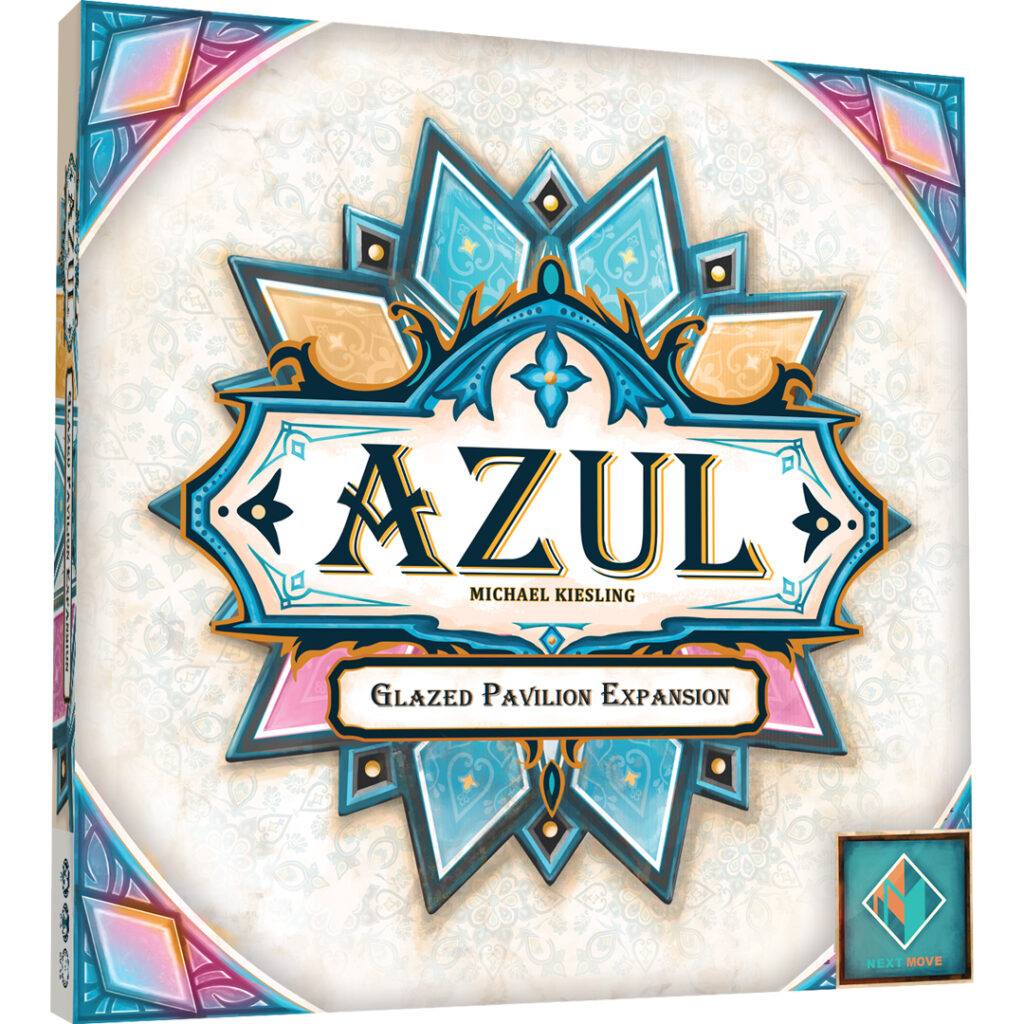
Expanding Azul: Summer Pavilion rather than the original Azul game, Glazed Pavilion does what Crystal Mosaic did – offering new player boards, and a plastic overlay. It won’t change much, but if you’re a regular player, could be worth picking up.
Buy Azul: Glazed Pavilion on Amazon
5211 Azul

Less of an expansion or variant, more of an Azul-themed-skin on another game, but you may see it listed for sale. There’s no tile drafting, and no tiles at all – this game is 5211, where you have a hand of five cards, place down two, replenish with one, and then repeat, scoring for colours rather than patterns. The only difference between 5211 versions is that it uses the Azul artwork on the cards, and there are no Azul related mechanics.
You probably only need to buy this if you’re debating picking up 5211 and prefer Azul artwork.
Combine Azul and 5211 on Amazon
Azul Mini (Azul and Summer Pavilion)
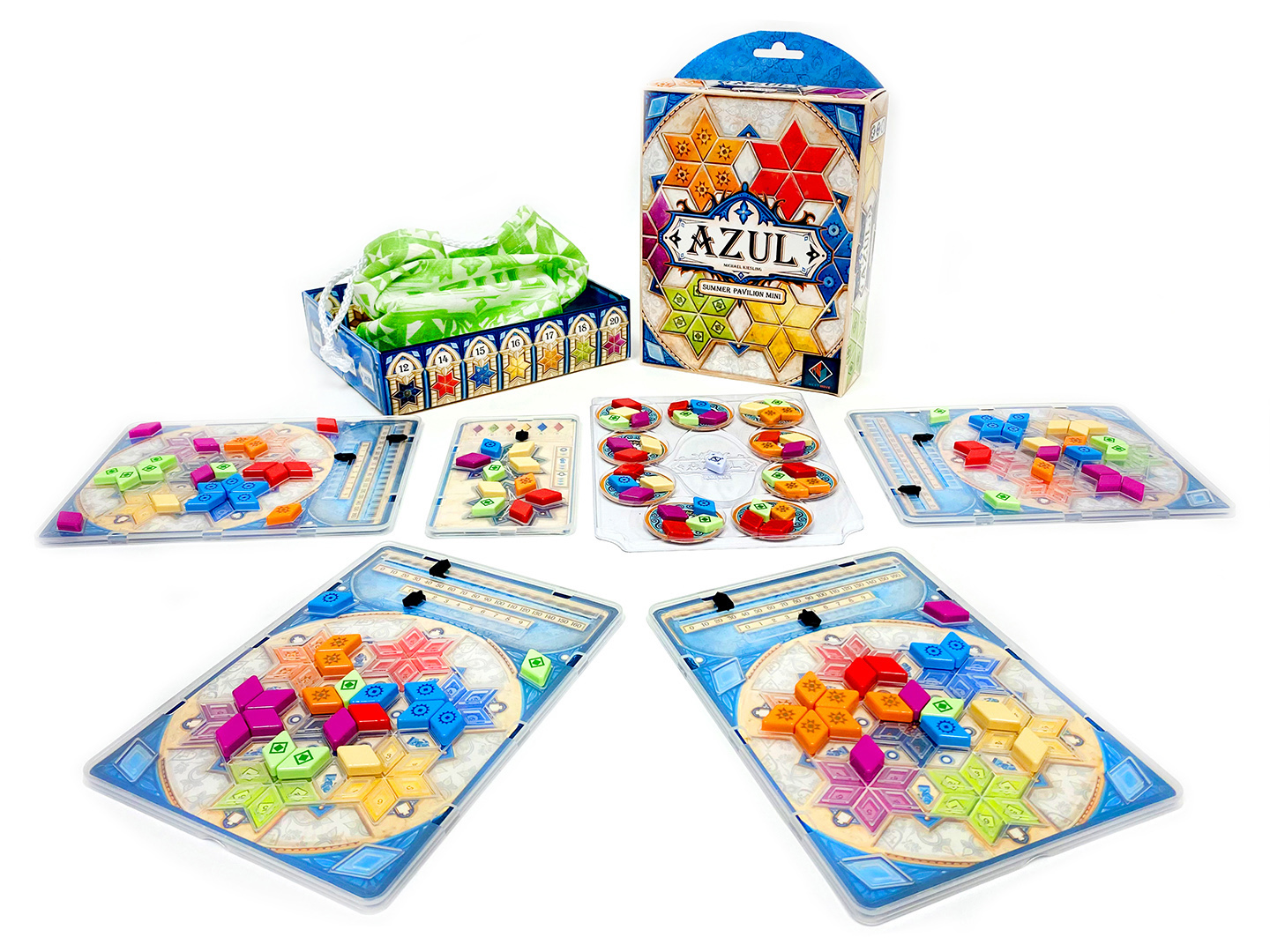
Exactly what it says on the tin, this is a smaller, more travel-sized version of Azul. Though the pieces are smaller, they sit nicely on the game board, and you lose nothing of the original game.
You don’t need to buy this if you’re happy with your copy of Azul, but if you frequently take it out of the house, or aren’t blessed with much storage space, it’s a perfectly fine alternative.
Conclusion
If you’re looking for a light, fun, easy to learn game, or to introduce friends to gaming, then you can’t go wrong with the original Azul. If you want a little more challenge, or something new on the original, try Azul: Summer Pavilion. If you found Azul to be too light, and aren’t attached to the mechanics, then Azul: Queens Garden is an option. The expansions aren’t necessary purchases as they don’t add huge amounts, but as a game board upgrade, the plastic overlays are great for frequent players. Lastly, if you don’t like Azul, there’s always 5211!
Sometimes we may include links to online retailers, from which we might receive a commission if you make a purchase. Affiliate links do not influence editorial coverage and will only be used when covering relevant products.







